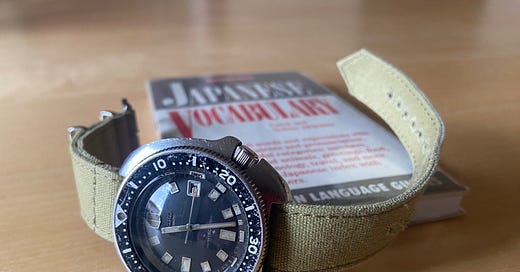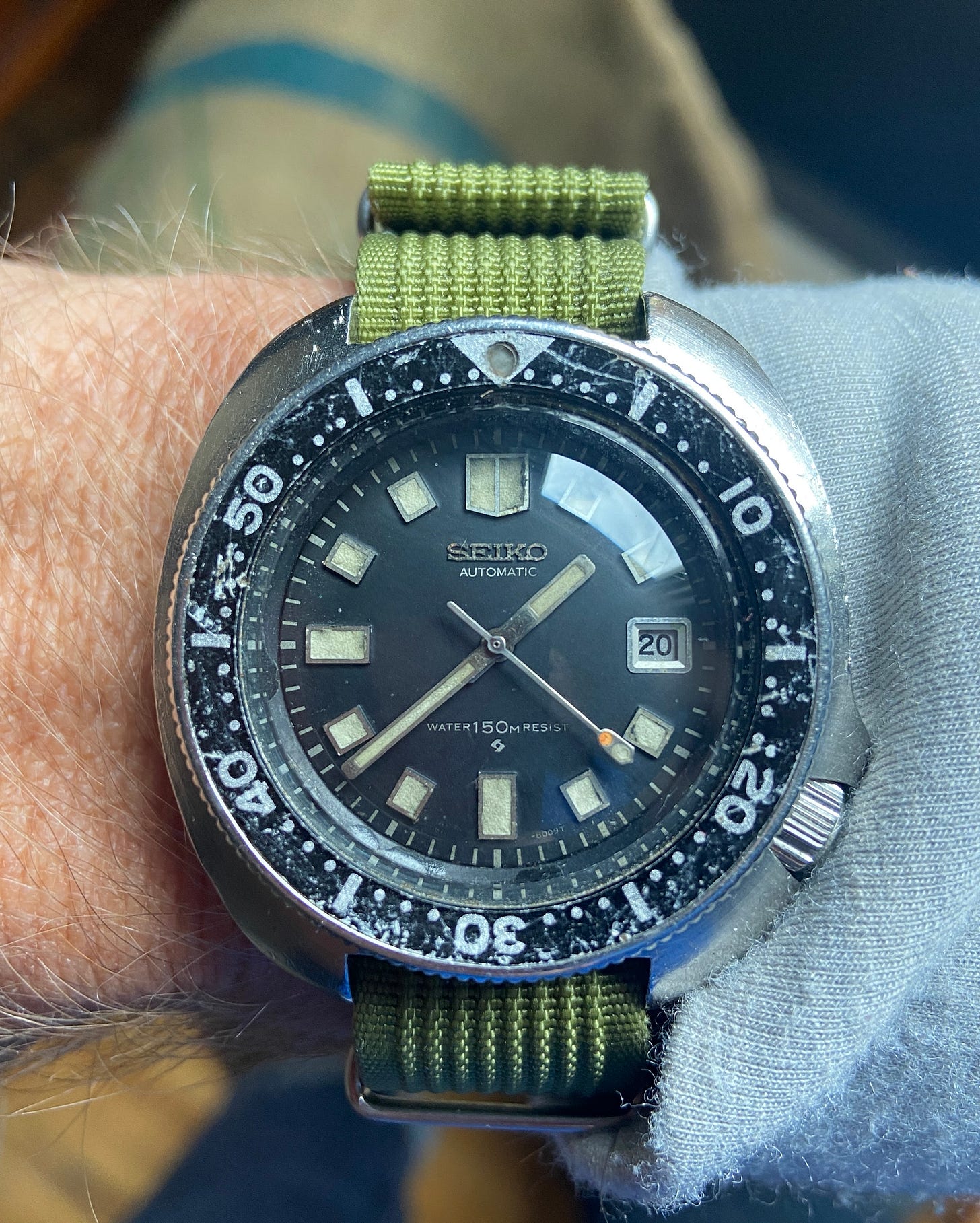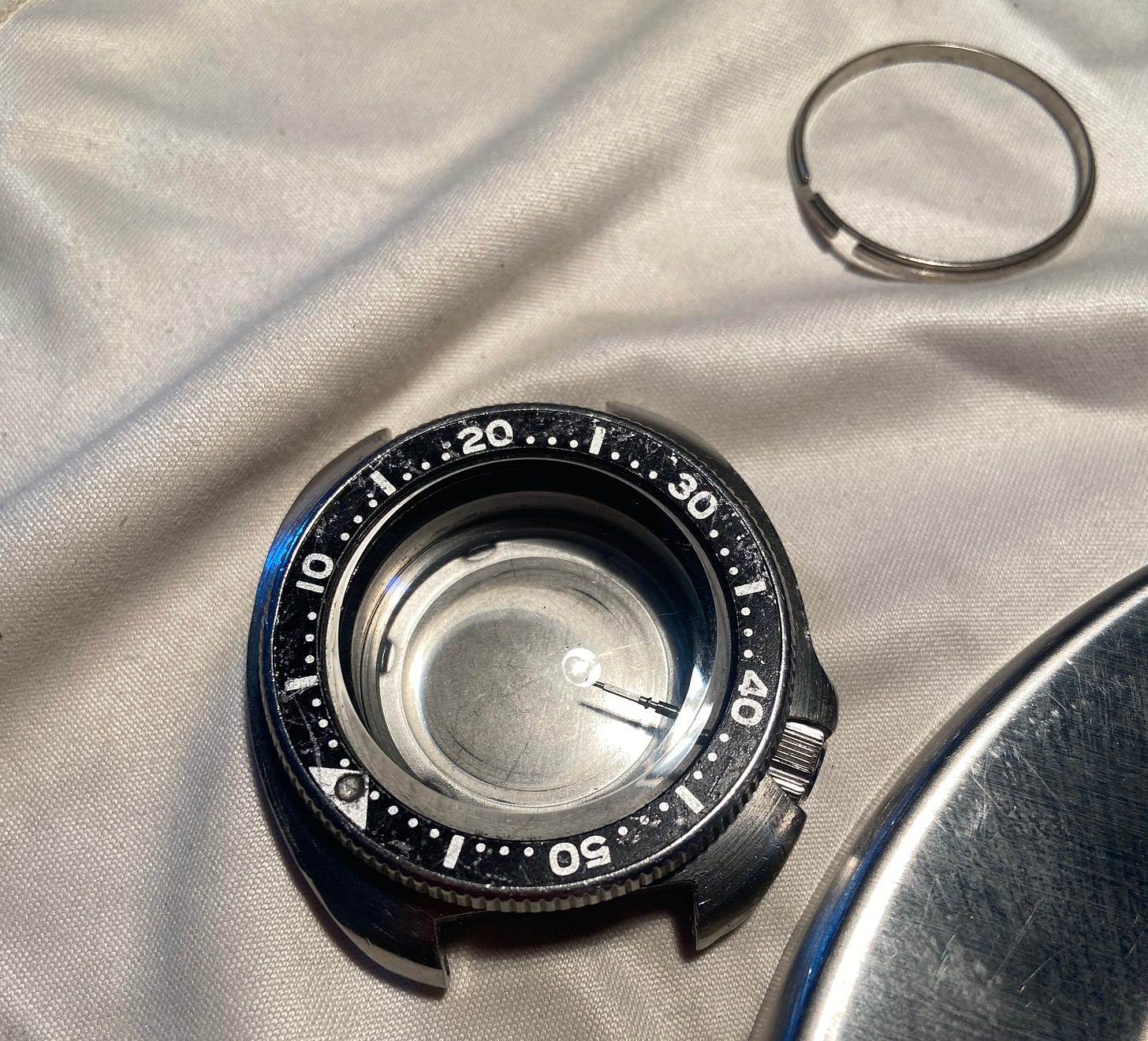For part 1, check out last week’s story.
Have you heard the story about the guy who turned a paperclip into a house, through a series of ever escalating trades? I’m on my way, though not quite so dramatically, and I might just quit while I’m ahead. You see, a couple years ago, I had a watch that I received as partial payment for a bit of copywriting and photography. I enjoyed it for a while but then stopped wearing it. When a friend asked to try it, he offered a vintage Seiko 6139 chronograph in return, first temporarily, then we decided to make the trade permanent. I’d like to think we both came out ahead. I had always wanted one of these yellow dial “Pogue” Seikos (named for the NASA astronaut who wore said watch on a SkyLab mission in 1973) and I wore it quite a bit at first. Then, being a dive watch guy at heart, it languished in my watch box for months on end. It really deserved better. Some vintage watches are best kept on a padded cushion, quietly gaining in value in a dark safe. Seikos are not those watches. They should be worn, just as old Land Rovers should be driven. They’re built to last and look better the more battered they become.
Around the time I was contemplating selling the Pogue I saw another old Seiko come available. It was a 6105, Seiko’s most iconic dive watch, the one worn by great polar explorers, scientists, US Navy divers, and the hero in one my favorite movies (Apocalypse Now). I’d owned two 6105s in the past, during my mad flipping days, where a watch barely lasted a month on my wrist before something else caught my eye. The first was the first generation “slim case” version (the 6105-8000 for those keeping score) and the second was the more familiar -8110 variety that Seiko sold right up until 1977. Looking back, I probably should have kept them both but then my wrist was about as promiscuous as an ostracod during full moon week. Here was my chance to right a past wrong. I sold the Pogue chronograph for exactly what the seller wanted for his 6105. The three-way deal was done in about 30 minutes and the old diver on my wrist within days. And now I want to wear it—a lot, and for everything. That presented a problem: it’s old.
My two primary reasons for deciding to quit vintage watches a while ago, were the long expired luminescent material on the dial and hands, and the questionable water resistance. I wear my watches 24/7, even to bed, and whether it’s a spontaneous swim or an insomnia-induced time check, vintage watches don’t usually cut it for either. So I largely stopped wearing them. Now I realize both of these shortcomings can be corrected, and I’ve had a vintage Doxa and a Tudor brought back up to diving snuff. But it’s not cheap and you have to send the watch away for a while. I’m too impatient—and cheap—for that.
Despite my short-sighted sale of my previous 6105, I did have the sense to keep the spare parts I had bought for it. So I decided to see what I could do to make the old diver at least somewhat less hydrophobic. Though the previous owner didn’t know the service history of the watch, the excellent condition of the crystal in comparison to the badly scarred bezel and case led me to believe that someone had looked after this one. Not to mention it arrived keeping excellent time, which was also a clue that it might have been serviced in the not so distant past. I carefully unscrewed the caseback and found a plump, well lubed rubber O-ring—a good sign. I decided to go deeper.
I removed the crown and stem, then the movement retention ring, and finally the 6105B automatic movement, leaving it under a dust cover for safe keeping. Then I reinserted the stem for a water pressure test. With the movement removed, even if the case leaked, it wouldn’t be a total loss. WIth the case suspended above a cylinder of water, I pumped up my inexpensive pressure tester to 5 bar (the rough equivalent of 50 meters of water depth) and waited five minutes. The fact that the stem, only secured by its O-ring seal, didn’t pop off was already a good sign. Then I lowered the case into the water and slowly released the air pressure. If there was a leak, bubbles would emanate in a steady stream from the faulty seal. Nothing. It was good to go. I reassembled it, added a dab of Loctite Blue to the stem to keep the crown threaded on, and here we are.
I’m not sure if there’s a Japanese expression similar to, “je ne sais quois,” but the Seiko 6105 has it in spades. There are some watches that look good on a wrist, across a room. It’s the way they look with a pushed-up sleeve, at a certain angle—its wearer holding a beer or a dive mask—and the way the light reflects off of the crystal. The Omega Speedmaster Professional is like that. So is an old Rolex Submariner—one with a plastic crystal. The 6105 has always had that appeal. Part of it is the flat but elegantly curved steel case, the way straps always seem a little too narrow for the watch’s diameter, the way the timing ring sits proud of the case, but especially the way the bevel of the crystal catches light. It produces a sort of glow, a halo around that quintessentially Seiko dial. Seiko makes a modern reissue of the 6105, called the “1970 recreation,” and it’s a fine timepiece that most people won’t hesitate to wear for rough duty. But it’s never quite had the same charm as its inspiration.
In comparison to the Speedmaster Mark III I wrote about last week, I have even less of an idea of this Seiko’s history. I bought it from a fellow Explorers Club member who lives in northeastern Ohio, near Lake Erie. Like me, he’s an enthusiastic Great Lakes wreck diver. But he didn’t own the watch for long, nor did he, as far as I know, wear it on any significant adventures. I’d still like to think it’s spent its working life in and around the region though. Though it earned its reputation on the wrists of frugal “rough men standing ready to do violence” in the jungles of Southeast Asia, in the 1970s, it would have been equally well suited for the frugal rough men working in and around the Great Lakes. Forget about the coasts, with their pedigreed hand-me-down graduation gift Rolexes. In the middle of the US, people have long frowned upon ostentation and anything that smacks of “fancy.” A Seiko would have fit the no-frills, “get ‘er done” ethic, while costing less than $100.
I can imagine this former navy man, back from Vietnam for three years, takes a diving job doing hull inspections at Bay Shipbuilding up in Sturgeon Bay. The ‘70s were a boom time for Bay, with 30 new lake freighters constructed there during the decade. It’s good work, but hard, and he takes all the overtime he can get. With the extra dough, he buys a new Jeep CJ-5 “Levi’s Edition,” in Renegade Orange with the denim interior and the factory hardtop. With a little left in his pocket, he drives down to Draeb Jewelers on Third Avenue. He needs a good, sturdy watch, one he won’t have to take off or worry about. There’s this dive watch in the display case, bigger than anything else in there, with a long black rubber strap that looks like it was pressed with a waffle iron. The salesperson takes it out, shakes it a couple of times and hands it to him. “It might not keep the best time, but it’ll run forever, no matter what,” he says.
The diver remembers the Seikos he saw in ‘Nam, and straps it on his wrist. Despite the bulk, it lies flat and comfortable. He spins the bezel and it responds with a satisfying click. “150 meters,” the dial reads. “Plenty,” he thinks, and fishes a wad of bills from his billfold: $95. The salesman sets the time for him, hands it back and tells him to keep it wound up.
“That won’t be a problem.” He tells the salesman he can throw the box away, straps the watch on his wrist, and he’s out of the door, into the Jeep, back to the shipyard for his shift, not to be taken off for two decades: under the ice, scraped on hull plating, banged on the Jeep’s roll cage, worn camping, roofing the cabin, and teaching his son to fish. When he got too old to care what time it was, he passed it down to the boy, who neglected and ultimately pawned it for $60 sometime in the late ‘90s. It was then passed around the Midwest for the next two decades until it found its way to me.
That sizable ding on the case at 4:00 just above the crown guard? The wrench slipped when he was torquing down a lug nut on a winter’s night tire change, slamming the watch against the Jeep’s fender. The scrape on the other side? A slip while climbing the ladder after a long prop inspection on the SS Arthur Anderson. The bezel is scraped and faded, a few dial markers fouled with black rot from moisture, to which it finally succumbed before its first service in the early 2000s.
I’ve no idea if this was the life to which this old Seiko 6105 was witness. Regardless, it led a hard existence, not babied or fetishized. This watch was given the respect it deserved, which is to say, it was ridden hard, put away wet. In the ‘70s, Seikos were cheap and tough. “Made in Japan” didn’t carry the cachet it does today. These watches were bought to simply do a job, not be photographed for Instagram or have 1,700 words written about them for a blog. But here we are. It’s a different era—we respect these old things for different reasons now, and that’s OK.
In Japanese, the term wabi sabi refers to the beauty reflected in an object’s imperfections and patina. It reminds us of the impermanence of everything, and is seen in the crumbling foundation of an ivy covered house, the chip in a porcelain mug, or the faded paint on an old truck. It is perhaps fitting that the watches that perhaps wear wabi sabi the best are from Japan. And while this Seiko 6105 is doing its best to remind me of its impermanence, I’ll enjoy it while it lasts.








Excellent story! I bought a Seiko 6309 in 1983 as I started Grad School at the University of Minnesota. Wore it nonstop for 5+ years at the U, at the St. Croix, on White Bear. When I started my first real job bought a Cartier Tank over a Rolex Sub because I already had the trusty 6309. At some point the 6309 entered the depths of my closet for over 20 years. When the Seiko 777 was released, I bought that watch and started looking for my 6309. It was still there (with it's original band), I hadn't 'lost' it. It is ever so slightly smaller than the 777, but reminded me of wonderful days gone by. The 6309 was in need of a service, and I just don't know a good place for service. So that's my one and only story of my 'vintage' Seiko diver.
I was very close to buying this very 6105 Jason, so I'm glad you saved me from it!
FWIW, I have a great 6309 already, that was serviced and relumed by Jack @ IWW. It runs like a top (of course), and looks like a watch from 1979, but glows close to my modern seikos. Well worth the expense IMHO, as I am similar in that I sleep in a watch and like to tell the time early in the AM